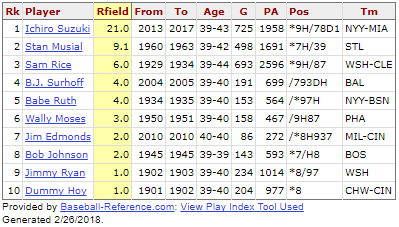This post is for voting and discussion in the 128th round of balloting for the Circle of Greats (COG). This is the last of four rounds adding to the list of candidates eligible to receive your votes those players born in 1973. Rules and lists are after the jump.
The new group of 1973-born players, in order to join the eligible list, must, as usual, have played at least 10 seasons in the major leagues or generated at least 20 Wins Above Replacement (“WAR”, as calculated by baseball-reference.com, and for this purpose meaning 20 total WAR for everyday players and 20 pitching WAR for pitchers). This fourth group of 1973-born candidates, including those with R-Z surnames, completes the roster of eligible 1973-born candidates and joins the eligible holdovers from previous rounds to comprise the full list of players eligible to appear on your ballots.
In addition to voting for COG election among players on the main ballot, there will be also be voting for elevation to the main ballot among players on the secondary ballot. For both ballots, which may be voted at the same time or in separate posts, voters must include three and only three eligible players. For the main ballot election, the one player who appears on the most ballots cast in the round is inducted into the Circle of Greats, while for the secondary ballot election, the one player appearing on the most ballots cast is elevated to the main ballot for the next COG election round. In the case of ties, a runoff election round will be held for COG election, while a tie-breaking process will be followed to determine the secondary ballot winner.
Players who fail to win either ballot but appear on half or more of the ballots that are cast win four added future rounds of ballot eligibility. Players who appear on 25% or more of the ballots cast, but less than 50%, earn two added future rounds of ballot eligibility. One additional round of eligibility is earned by any player who appears on at least 10% of the ballots cast or, for the main ballot only, any player finishing in the top 9 (including ties) in ballot appearances. Holdover candidates on the main ballot who exhaust their eligibility will drop to the secondary ballot for the next COG election round, as will first time main ballot candidates who attract one or more votes but do not earn additional main ballot eligibility. Secondary ballot candidates who exhaust their eligibility will drop from that ballot, but will become eligible for possible reinstatement in a future Redemption round election.
All voting for this round closes at 11:59 PM EST Sunday, March 4th, while changes to previously cast ballots are allowed until 11:59 PM EST Friday, March 2nd.
If you’d like to follow the vote tally, and/or check to make sure I’ve recorded your vote correctly, you can see my ballot-counting spreadsheet for this round here: COG 1973 Part 4 Vote Tally. I’ll be updating the spreadsheet periodically with the latest votes. Initially, there is a row in the spreadsheet for every voter who has cast a ballot in any of the past rounds, but new voters are entirely welcome — new voters will be added to the spreadsheet as their ballots are submitted. Also initially, there is a column for each of the holdover candidates; additional player columns from the new born-in-1973 group will be added to the spreadsheet as votes are cast for them.
Choose your three players from the lists below of eligible players. The ten current holdovers are listed in order of the number of future rounds (including this one) through which they are assured eligibility, and alphabetically when the future eligibility number is the same. The 1973 birth-year players are listed below in order of the number of seasons each played in the majors, and alphabetically among players with the same number of seasons played.
Holdovers:
| MAIN BALLOT | Eligibility | Secondary BALLOT | ELIGIBILITY |
|---|---|---|---|
| Kevin Brown | 10 rounds | Andre Dawson | 7 rounds |
| Luis Tiant | 7 rounds | Ken Boyer | 3 rounds |
| Dick Allen | 5 rounds | Ted Lyons | 3 rounds |
| Bill Dahlen | 4 rounds | Rick Reuschel | 3 rounds |
| Manny Ramirez | 4 rounds | Willie Randoph | 2 rounds |
| Graig Nettles | 3 rounds | Todd Helton | 2 rounds |
| Richie Ashburn | 2 rounds | Andy Pettitte | this round ONLY |
| Ted Simmons | 2 rounds | ||
| Bobby Wallace | 2 rounds | ||
| Dwight Evans | this round ONLY | ||
| Don Sutton | this round ONLY |
Everyday Players (born in 1973, ten or more seasons played in the major leagues or at least 20 WAR, R-Z surname):
Ichiro Suzuki
Mike Sweeney
Dmitri Young
Todd Walker
Desi Relaford
Chris Stynes
Pitchers (born in 1973, ten or more seasons played in the major leagues or at least 20 WAR, R-Z surname):
Julian Tavarez
Jason Schmidt
Brett Tomko
Scott Schoeneweis
Justin Speier
Ismael Valdez
John Thomson


